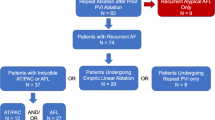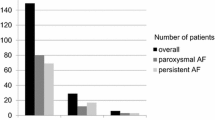Abstract
Background
Early recurrence of atrial fibrillation (ERAF) and delayed cure are commonly observed after atrial fibrillation (AF) ablation. The purpose of this study was to determine the predictors of ERAF and delayed cure after a single pulmonary vein isolation (PVI) performed in paroxysmal AF patients without structural heart disease.
Methods and results
In 108 consecutive patients (93 men, 15 women; mean age 51 ± 8 years) with paroxysmal AF and no structural heart disease, segmental PVI guided by a Lasso catheter was performed. Forty-one percent (44/108) AF patients had ERAF after a single PVI. Univariate analysis revealed that left atrial diameter (p = 0.004), age (p = 0.024) and P-wave dispersion (p = 0.045) were significantly related to ERAF. Logistic regression analysis revealed that left atrial enlargement was the only independent predictor of ERAF (odds ratio [OR] 1.17; 95% confidence interval [CI] 1.04–1.30, p = 0.006). Delayed cure occurred in 32% (14/44) patients with ERAF. P-wave dispersion (p = 0.001), left atrial diameter (p = 0.008) were significantly related to delayed cure. P-wave dispersion was the only independent predictive factor of delayed cure (OR 0.91; 95% CI 0.85–0.97, p = 0.004).
Conclusions
Elderly patients with left atrial enlargement and a high dispersion of P wave are susceptible to ERAF after a single PVI. Left atrial enlargement is the only independent predictor of ERAF. Among patients with ERAF, those with less P-wave dispersion and less left atrial diameter have a higher probability of delayed cure. P-wave dispersion can independently predict delayed cure.
Similar content being viewed by others
References
Haissaguerre, M., Jais, P., Shah, D. C., Takahashi, A., Hocini, M., Quiniou, G., et al. (1998). Spontaneous initiation of atrial fibrillation by ectopic beats originating in the pulmonary veins. New England Journal of Medicine, 339, 659–666.
Haissaguerre, M., Shah, D. C., Jais, P., Hocini, M., Yamane, T., Deisenhofer, I., et al. (2000). Electrophysiological breakthroughs from the left atrium to the pulmonary veins. Circulation, 102, 2463–2465.
Lee, S. H., Tai, C. T., Hsieh, M. H., Tsai, C. F., Lin, Y. K., Tsao, H. M., et al. (2004). Predictors of early and late recurrence of atrial fibrillation after catheter ablation of paroxysmal atrial fibrillation. Journal of Interventional Cardiology Electrophysiology, 10, 221–226.
Bertaglia, E., Stabile, G., Senatore, G., Zoppo, F., Turco, P., Amellone, C., et al. (2005). Predictive value of early atrial tachyarrhythmias recurrence after circumferential anatomical pulmonary vein ablation. Pacing Clinical Electrophysiology, 28, 366–371.
Oral, H., Knight, B. P., Ozaydin, M., Tada, H., Chugh, A., Hassan, S., et al. (2002). Clinical significance of early recurrences of atrial fibrillation after pulmonary vein isolation. Journal of the American College Cardiology, 40, 100–104.
O’Donnell, D., Furniss, S. S., Dunuwille, A., & Bourke, J. P. (2003). Delayed cure despite early recurrence after pulmonary vein isolation for atrial fibrillation. American Journal of Cardiology, 91, 83–85.
Dong, J. Z., Liu, X. P., Long, D. Y., Liu, X. Q., Wang, J., Fang, D. P., et al. (2005). Impact of different ablation strategies on the delayed cure after trans-catheter ablation for treating patients with atrial fibrillation. Chinese Medical Journal (Engl), 118, 1150–1155.
Vasamreddy, C. R., Lickfett, L., Jayam, V. K., Nasir, K., Bradley, D. J., Eldadah, Z., et al. (2004). Predictors of recurrence following catheter ablation of atrial fibrillation using an irrigated-tip ablation catheter. Journal of Cardiovascular Electrophysiology, 15, 692–697.
Gerstenfeld, E. P., Sauer, W., Callans, D. J., Dixit, S., Lin, D., Russo, A. M., et al. (2006). Predictors of success after selective pulmonary vein isolation of arrhythmogenic pulmonary veins for treatment of atrial fibrillation. Heart Rhythm, 3, 165–170.
Andrikopoulos, G. K., Dilaveris, P. E., Richter, D. J., Gialafos, E. J., Synetos, A. G., & Gialafos, J. E. (2000). Increased variance of P-wave duration on the electrocardiogram distinguishes patients with idiopathic paroxysmal atrial fibrillation. Pacing and Clinical Electrophysiology, 23, 1127–1132.
Ozdemir, O., Soylu, M., Demir, A. D., Alyan, O., Topaloglu, S., Geyik, B., et al. (2006). Does p-wave dispersion predict the atrial fibrillation occurrence after direct-current shock therapy? Angiology, 57, 93–98.
Nanthakumar, K., Plumb, V. J., Epstein, A. E., Veenhuyzen, G. D., Link, D., & Kay, G. N. (2004). Resumption of electrical conduction in previously isolated pulmonary veins: rationale for a different strategy? Circulation, 109, 1226–1229.
Lemola, K., Hall, B., Cheung, P., Good, E., Han, J., Tamirisa, K., et al. (2004). Mechanisms of recurrent atrial fibrillation after pulmonary vein isolation by segmental ostial ablation. Heart Rhythm, 1, 197–202.
Pappone, C., Oreto, G., Rosanio, S., Vicedomini, G., Tocchi, M., Gugliotta, F., et al. (2001). Atrial electroanatomic remodeling after circumferential radiofrequency pulmonary vein ablation: Efficacy of an anatomic approach in a large cohort of patients with atrial fibrillation. Circulation, 104, 2539–2544.
Coumel, P. (1994). Paroxysmal atrial fibrillation: a disorder of autonomic tone? European Heart Journal, 15(Suppl A), 9–16.
Martinez-Pellus, A. E., Merino, P., Bru, M., Canovas, J., Seller, G., Sapina, J., et al. (1997). Endogenous endotoxemia of intestinal origin during cardiopulmonary bypass. Intensive Care Medicine, 23, 1251–1257.
Fenelon, G., & Brugada, P. (1996). Delayed effects of radiofrequency energy: mechanisms and clinical implications. Pacing Clinical Electrophysiology, 19, 484–489.
Mangrum, J. M., Everett, T. H. 4th, Mitchell, M. A., McRury, I. D., Li, H., & Haines, D. E. (2002). The effects of reverse atrial electrical remodeling on atrial defibrillation thresholds. Pacing Clinical Electrophysiology, 25, 470–476.
Solti, F., Vecsey, T., Kekesi, V., & Juhasz-Nagy, A. (1989). The effect of atrial dilatation on the genesis of atrial arrhythmias. Cardiovascular Research, 23, 882–885.
Spach, M. S., & Dolber, P. C. (1986). Relating extracellular potentials and their derivatives to anisotropic propagation at a microscopic level in human cardiac muscle: Evidence for electrical uncoupling of side-to-side fiber connections with increasing age. Circulation Research, 58, 356–371.
Kistler, P. M., Sanders, P., Fynn, S. P., Stevenson, I. H., Spence, S. J., Vohra, J. K., et al. (2004). Electrophysiologic and electroanatomic changes in the human atrium associated with age. Journal of the American College Cardiology, 44, 109–116.
Dilaveris, P. E., Gialafos, E. J., Sideris, S. K., Theopistou, A. M., Andrikopoulos, G. K., Kyriakidis, M., et al. (1998). Simple electrocardiographic markers for the prediction of paroxysmal idiopathic atrial fibrillation. American Heart Journal, 135(5 Pt 1), 733–738.
Aras, D., Maden, O., Ozdemir, O., Aras, S., Topaloglu, S., Yetkin, E., et al. (2005). Simple electrocardiographic markers for the prediction of paroxysmal atrial fibrillation in hyperthyroidism. International Journal of Cardiology, 99, 59–64.
Kose, S., Aytemir, K., Sade, E., Can, I., Ozer, N., Amasyali, B., et al. (2003). Detection of patients with hypertrophic cardiomyopathy at risk for paroxysmal atrial fibrillation during sinus rhythm by P-wave dispersion. Clinical Cardiology, 26, 431–434.
Tukek, T., Yildiz, P., Akkaya, V., Karan, M. A., Atilgan, D., Yilmaz, V., et al. (2002). Factors associated with the development of atrial fibrillation in COPD patients: the role of P-wave dispersion. Annals of Noninvasive Electrocardiology, 7, 222–227.
Aytemir, K., Amasyali, B., Kose, S., Kilic, A., Abali, G., Oto, A., et al. (2004). Maximum P-wave duration and P-wave dispersion predict recurrence of paroxysmal atrial fibrillation in patients with Wolff–Parkinson–White syndrome after successful radiofrequency catheter ablation. Journal of Interventional Cardiology Electrophysiology, 11, 21–27.
Gang, Y., Hnatkova, K., Mandal, K., Ghuran, A., & Malik, M. (2004). Preoperative electrocardiographic risk assessment of atrial fibrillation after coronary artery bypass grafting. Journal of Cardiovascular Electrophysiology, 15, 1379–1386.
Tezcan, U. K., Amasyali, B., Can, I., Aytemir, K., Kose, S., Yavuz, I., et al. (2004). Increased P-wave dispersion and maximum P-wave duration after hemodialysis. Annals of Noninvasive Electrocardiology, 9, 34–38.
Author information
Authors and Affiliations
Corresponding author
Additional information
This study was supported by National Natural Science Foundation of China. (NSFC No.30470704). There is not any potential conflict of interest.
Rights and permissions
About this article
Cite this article
Jiang, H., Lu, Z., Lei, H. et al. Predictors of early recurrence and delayed cure after segmental pulmonary vein isolation for paroxysmal atrial fibrillation without structural heart disease. J Interv Card Electrophysiol 15, 157–163 (2006). https://doi.org/10.1007/s10840-006-9003-y
Received:
Accepted:
Published:
Issue Date:
DOI: https://doi.org/10.1007/s10840-006-9003-y




